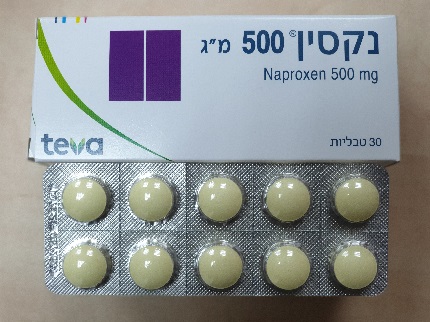Quest for the right Drug

נקסין 500 מ"ג NAXYN 500 MG (NAPROXEN)
תרופה במרשם
תרופה בסל
נרקוטיקה
ציטוטוקסיקה
צורת מתן:
פומי : PER OS
צורת מינון:
טבליה : TABLETS
עלון לרופא
מינוניםPosology התוויות
Indications תופעות לוואי
Adverse reactions התוויות נגד
Contraindications אינטראקציות
Interactions מינון יתר
Overdose הריון/הנקה
Pregnancy & Lactation אוכלוסיות מיוחדות
Special populations תכונות פרמקולוגיות
Pharmacological properties מידע רוקחי
Pharmaceutical particulars אזהרת שימוש
Special Warning עלון לרופא
Physicians Leaflet
Interactions : אינטראקציות
4.5 Interaction with other medicinal products and other forms of interaction Concomitant administration of antacid or colestyramine can delay the absorption of naproxen but does not affect its extent. Concomitant administration of food can delay the absorption of naproxen, but does not affect its extent. It is considered unsafe to take NSAIDs in combination with anti-coagulants such as warfarin or heparin unless under direct medical supervision, as NSAIDs may enhance the effects of anti-coagulants (see Section 4.4). Other analgesics including cyclooxygenase-2 selective inhibitors: Avoid concomitant use of two or more NSAIDs (including aspirin) as this may increase the risk of adverse effects (see Section 4.4). Acetylsalicylic acid Clinical pharmacodynamic data suggest that concomitant naproxen usage for more than one day consecutively may inhibit the effect of low-dose acetylsalicylic acid on platelet activity and this inhibition may persist for up to several days after stopping naproxen therapy. The clinical relevance of this interaction is not known. Due to the high plasma protein binding of naproxen, patients simultaneously receiving hydantoins, anticoagulants, other NSAIDs, aspirin or a highly protein-bound sulfonamide should be observed for signs of overdosage of these drugs. Patients simultaneously receiving Naxyn and a hydantoin, sulfonamide or sulfonylurea should be observed for adjustment of dose if required. No interactions have been observed in clinical studies with naproxen and anticoagulants or sulfonylureas, but caution is nevertheless advised since interaction has been seen with other non-steroidal agents of this class. Caution is advised when Naxyn is co-administered with diuretics as there can be a decreased diuretic effect. The natriuretic effect of furosemide has been reported to be inhibited by some drugs of this class. Diuretics can increase the risk of nephrotoxicity of NSAIDs. Inhibition of renal lithium clearance leading to increases in plasma lithium concentrations has also been reported. Naproxen and other non-steroidal anti-inflammatory drugs can reduce the antihypertensive effect of anti-hypertensives. Concomitant use of NSAIDs with ACE inhibitors or angiotensin- II receptor antagonists may increase the risk of renal impairment, especially in patients with pre-existing poor renal function (See Section 4.4). Probenecid given concurrently increases naproxen plasma levels and extends its half-life considerably. Caution is advised where methotrexate is given concurrently because of possible enhancement of its toxicity, since naproxen, among other nonsteroidal anti-inflammatory drugs, has been reported to reduce the tubular secretion of methotrexate in an animal model. NSAIDs may exacerbate cardiac failure, reduce GFR and increase plasma cardiac glycoside levels when co-administered with cardiac glycosides. As with all NSAIDs caution is advised when ciclosporin is co-administered because of the increased risk of nephrotoxicity. NSAIDs should not be used for 8 - 12 days after mifepristone administration as NSAIDs can reduce the effects of mifepristone. As with all NSAIDs, caution should be taken when co-administering with cortico-steroids because of the increased risk of gastrointestinal ulceration or bleeding. Animal data indicate that NSAIDs can increase the risk of convulsions associated with quinolone antibiotics. Patients taking quinolones may have an increased risk of developing convulsions. There is an increased risk of gastrointestinal bleeding (see Section 4.4) when anti-platelet agents and selective serotonin reuptake inhibitors (SSRIs) are combined with NSAIDs. There is a possible risk of nephrotoxicity when NSAIDs are given with tacrolimus. There is an increased risk of haematological toxicity when NSAIDs are given with zidovudine. There is evidence of an increased risk of haemarthroses and haematoma in HIV(+) haemophiliacs receiving concurrent treatment with zidovudine and ibuprofen. It is suggested that Naxyn therapy be temporarily discontinued 48 hours before adrenal function tests are performed, because naproxen may artifactually interfere with some tests for 17-ketogenic steroids. Similarly, naproxen may interfere with some assays of urinary 5- hydroxyindoleacetic acid.

שימוש לפי פנקס קופ''ח כללית 1994
Rheumatoid arthritis & osteoarthritis, non rheumatic inflammatory conditions, acute gouty arthritis, dysmenorrhea
תאריך הכללה מקורי בסל
01/01/1995
הגבלות
תרופה שאושרה לשימוש כללי בקופ'ח
מידע נוסף
